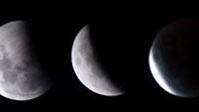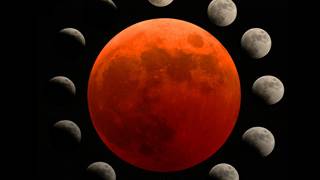Upcoming total lunar eclipse will be an unusually long one (June 2011)
Source: winnipegfreepress.com

The year’s first total eclipse of the moon will last an unusually long time, a rare celestial treat for a wide swath of the globe.
Except if you’re in the United States and Canada. North America will be left out of Wednesday’s lunar spectacle, which will be visible from start to finish from eastern Africa, central Asia, the Middle East and western Australia — weather permitting.
The period when Earth’s shadow completely blocks the moon — known as totality — will last a whopping 1 hour and 40 minutes. The last time the moon was covered for this long was in July 2000, when it lasted 7 minutes longer than that.
The full moon normally glows from reflected sunlight. A total lunar eclipse occurs when the moon glides through the long shadow cast by the Earth and is blocked from the sunlight that illuminates it.
As the moon plunges deeper into the Earth’s shadow, the disk will appear to gradually change colour, turning from silver to orange or red. This is because some indirect sunlight still reaches the moon after passing through the Earth’s atmosphere, which scatters blue light. Only red light strikes the moon, giving it an eerie crimson hue.
It’s difficult to predict the exact shade the moon will take, which will depend on how much dust and clouds are in the atmosphere during the eclipse.
Since the moon will pass close to the centre of the Earth’s shadow, the total eclipse phase will be longer than usual, said NASA eclipse expert Fred Espenak at the Goddard Space Flight Center in Maryland.
The entire eclipse will last a little over 5 1/2 hours. Observers in Europe will miss the first part of the show because it will occur before the moon rises. Eastern Asia and eastern Australia won’t catch the final stages, which will happen after the moon sets. Portions of South America will be able see the moon entirely shrouded.
Unlike solar eclipses, lunar eclipses are safe to watch with the naked eye.
Read the full article at: winnipegfreepress.com
Top Image: In this March 4,2007 file photo showing a full moon is eclipsed by the earth’s shadow in this seven pictures combination, from left, seen in Nairobi, Kenya. Mark your calendars. This year’s first total eclipse of the moon will last unusually long, a rare celestial treat for a wide swath of the globe. If you’re in eastern Africa, central Asia, Middle East and western Australia, you should be able to view the entire lunar spectacle if the weather cooperates. Total lunar elipse will occur on June 15. (AP Photo/Akmal Rajput,File)
Video from: YouTube.com






















